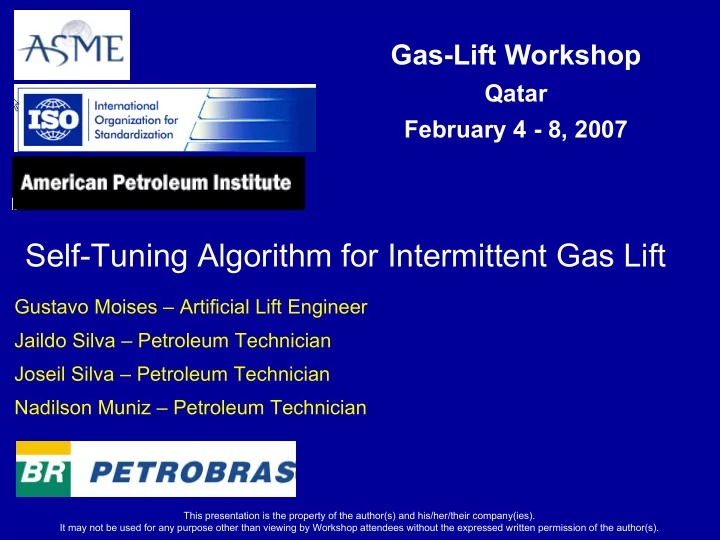

Gas-Lift Workshop Qatar February 4 - 8, 2007 Self-Tuning Algorithm for Intermittent Gas Lift Gustavo Moises – Artificial Lift Engineer Jaildo Silva – Petroleum Technician Joseil Silva – Petroleum Technician Nadilson Muniz – Petroleum Technician This presentation is the property of the author(s) and his/her/their company(ies). It may not be used for any purpose other than viewing by Workshop attendees without the expressed written permission of the author(s).
Summary 1) Abstract 2) Starting Point 3) Solution Design 4) Pilot Implementation 5) Lessons Learned 6) Conclusion 2007 Gas-Lift Workshop 2 Feb. 4 - 8, 2007
Abstract This work describes a self-tuning algorithm that was developed in PETROBRAS to identify equipment failures and behavior changes of intermittent Gas Lift wells Prior Objective: Improve asset production cycle efficiency 2007 Gas-Lift Workshop 3 Feb. 4 - 8, 2007
Starting Point Snap Shot • Daily Analysis of 150 Wells; • Low Produced Oil Rate per Well; • Delayed Equipment Failure Diagnoses; • Complex Production Losses Identification; • Limited Number of Employees; • One Controller per Well; • PETROBRAS in House SCADA System; 2007 Gas-Lift Workshop 4 Feb. 4 - 8, 2007
Starting Point WAN LAN DB LAN 2007 Gas-Lift Workshop 5 Feb. 4 - 8, 2007
Starting Point 2007 Gas-Lift Workshop 6 Feb. 4 - 8, 2007
Solution Design Petroleum Technician Expertise made by Preliminary Analysis of • Signature of Casing Pressure; • Signature of Tubing Pressure; • Closed Pressure Limit of Gas Lift Valve ; • Geometry of Well; • Valves Position; 2007 Gas-Lift Workshop 7 Feb. 4 - 8, 2007
Solution Design Signature of Casing Pressure (CP) 1) Normal Signature : Major Points Identification A. Surface On-Off Valve Opening; B. Gas Lift Valve Opening; C. Surface On-Off Valve Closure; D. Gas Lift Valve Closure; E. End of Acquisition Time; 2007 Gas-Lift Workshop 8 Feb. 4 - 8, 2007
Solution Design Signature of Casing Pressure (CP) Most Common Equipment Failures Signatures 2 ) Surface On-Off Valve Opening 3) Gas Lift Valve Opening Failure Failure 2007 Gas-Lift Workshop 9 Feb. 4 - 8, 2007
Solution Design Signature of Casing Pressure (CP) Most Common Equipment Failures Signatures 4) Casing Leakage 5) Surface On-Off Valve Leakage 2007 Gas-Lift Workshop 10 Feb. 4 - 8, 2007
Solution Design Signature of Casing Pressure (CP) Events described by binary variables I) Was the Surface On-Off Valve opened? Yes / No II) Was the Gas Lift Valve opened? Yes / No III) Is there any Casing Leakage? Yes / No IV) Is there any Surface On-Off Valve Leakage? Yes / No V) If there is a leakage, is it severe? Yes / No VI) Is the Casing Pressure Signature normal? Yes / No 2007 Gas-Lift Workshop 11 Feb. 4 - 8, 2007
Solution Design Signature of Casing Pressure (CP) Question Question Question Question Question Question I II III IV V VI Signature Yes Yes No No - Yes 1 Signature No No - - - No 2 Signature Yes No - - - No 3 Signature Yes Yes Yes No Yes / No No 4 Signature Yes Yes No Yes Yes / No No 5 2007 Gas-Lift Workshop 12 Feb. 4 - 8, 2007
Solution Design Signature of Tubing Pressure (TP) 1) Production Signature : Major Points Identification A. Surface On-Off Valve Opening; B. Beginning of Slug Detection; C. Maximum Tubing Pressure; D. End of Slug Detection; E. End of Acquisition Time; 2007 Gas-Lift Workshop 13 Feb. 4 - 8, 2007
Solution Design Signature of Tubing Pressure (TP) 2) No Production Signature If {C>A} THEN{PRODUCTION=YES} ELSE {PRODUCTION=NO} END 2007 Gas-Lift Workshop 14 Feb. 4 - 8, 2007
Solution Design Applied Methodology Inside of Well Controller • Major Points Identification; • Comparisons based on If {TRUE} THEN { PROCEDURE 1} ELSE {PROCEDURE 2} END; • Select Principal Equipment Failure from Error Message Tree ; • Send Error to the SCADA System via Radio; 2007 Gas-Lift Workshop 15 Feb. 4 - 8, 2007
Pilot Implementation Pilot was implemented by Waves 1) 2 wells a) Detect and Correct logical problem; b) Measure technician reaction; c) Explain how the algorithm works; d) Determine Error Tree priority; 2) 30 Wells a) Definition of Responsibility Matrix; b) Analysis of false Error messages; 3) Broad Implementation 2007 Gas-Lift Workshop 16 Feb. 4 - 8, 2007
Lessons Learned 1) Listen to asset team; 2) Work with asset team (Synergy); 3) Before broad implementation, make sure that the algorithm works properly and doesn’t affect the whole system; 4) Be patient!!!! Apply Change Management is not an easy task; 5) By the end, it will be worthy; 6) Keep indicators tracking ; 7) Be prepare for maintenance and new implementations; 2007 Gas-Lift Workshop 17 Feb. 4 - 8, 2007
Conclusion Connection between Production and Maintenance areas is very important to the success of in site well applications. It is necessary to add value to all information acquired from wells. Surveillance and Diagnostic Systems can help to increase the asset efficiency, minimizing production loss. 2007 Gas-Lift Workshop 18 Feb. 4 - 8, 2007
Conclusion Thank you! Questions???? 2007 Gas-Lift Workshop 19 Feb. 4 - 8, 2007
Recommend
More recommend